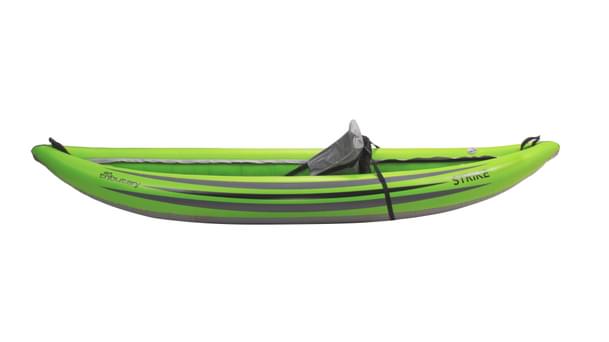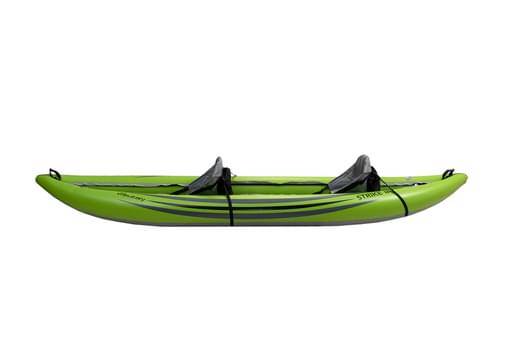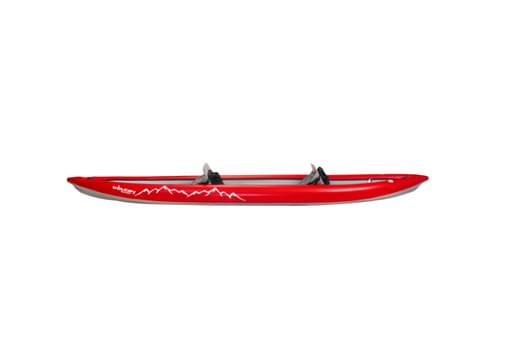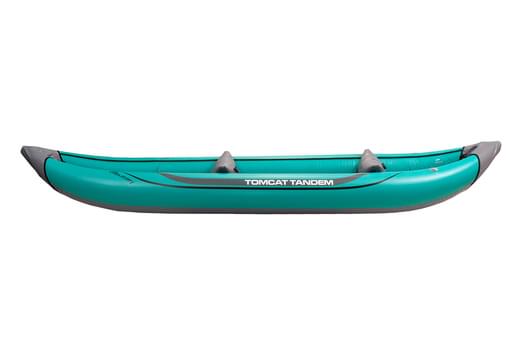- Home
- Gear & Reviews
- Shearwater 16 / Hybrid Kit
Shearwater 16 / Hybrid Kit

Shearwater 16 / Hybrid Kit Options
Shearwater 16 / Hybrid Kit Description
It's been nine years since the Chesapeake line of stitch-and-glue sea kayaks became a touchstone for touring performance in a build-it-yourself package. The Chesapeakes are the mainstay of CLC's kit kayak business, with thousands under construction all over the world. The Chesapeakes excel as comfortable touring kayaks that paddle well and weigh 20 pounds less than their plastic equivalents. And they're easy to build. What would be the next step?
There are three Shearwater singles, variously 17', 16', and 14.5'. The 17 is sized for paddlers who weigh from 160 to 220 pounds, max shoe size Men's 12-1/2. The Shearwater 16 accommodates 120-190lbs, max shoe size Men's 10. The Shearwater 14 is actually 14'6" and is designed for paddlers 100-150lbs, max inseam of 30", and shoe size 10 max.
Shearwater 16 / Hybrid Kit Specs and Features
- Structure: Rigid / Hard Shell
- Cockpit Type: Sit Inside
- Seating Configuration: Solo
- Ideal Paddler Size: Average Adult, Larger Adult
- Skill Level: Beginner, Intermediate, Advanced
- Ideal Paddler Size: Average Adult, Larger Adult
- Skill Level: Beginner, Intermediate, Advanced
Chesapeake Light Craft
Shearwater 16 / Hybrid Kit Reviews
Read reviews for the Shearwater 16 / Hybrid Kit by Chesapeake Light Craft as submitted by your fellow paddlers. All of the reviews are created and written by paddlers like you, so be sure to submit your own review and be part of the community!
This is an additional performance related review, missing from my earlier review. I…
I am a 140 lb, 5'4" experienced paddler, probably L3 or 3 star.
My prior ride was an Eddyline Merlin LT.
Initial stability is moderate. The shallow V bottom will feel a little less stable at rest (somewhat jittery) than a flatter-bottomed rec boat or an oval-bottomed boat aimed at beginner to intermediate paddlers. Beginning paddlers and experienced recreational paddlers may not feel comfortable in this boat when they are not actively paddling. This does not mean the boat is likely to flip when standing still, it just has a bit of a wiggly feel.
Secondary stability is high when underway and with a shallow lean that puts one of the bottom bilge panels (shallow V) flat in the water. When leaned all the way to the shear panel (right before the cockpit rim hits the water), it looses that comfortingly stable feel, but by the time an advanced paddler gains that big edged-turn, they have ninja skills. I'm almost there...
Cruising speed is great. I've had no problem keeping up with the big boys in their big boats, in fact, at least three of the guys I beat in the last race ( my second endurance event) went out and bought racing surfskiis or racing kayaks. Don't know if my boat and I played a factor in their decisions, or not, but it is fun to think that I built such a great boat.
This boat has a very nice balance of tracking & nimbleness. She tracks fairly well, but has enough rocker to feel maneuverable. The boat rolls fairly easily. The back deck is low enough to do Greenland-style layback rolls. The sweep roll is also easy in his boat. However, when upside-down without a sprayskirt, the cockpit somehow creates a suction cup that makes it difficult to pull the bow up (think T-rescue) or to perform a renter-and-roll without the extra umph a paddle float provides. It is far easier to flip the boat first then haul it up onto a rescue boat to empty the cockpit. Just a little quirk, not a fatal flaw.
The seat + back band as provided is adequate. I like the back band- it forces one to use good posture and separate the upper body from the boat. The seat needs improvement. I added extra foam to raise the seat out of the shallow V and for thigh support. A custom seat is on my wish list.
The boat is light-- significantly lighter than a rotomolded plastic boat and thus it is far easier to car-top by myself. The light weight makes the value of this boat closer to that of a thermoformed plastic or composite boat, which means this boat is priced at half what an equivalent manufactured boat would cost-- a good value!
I don't have much experience in big winds and big water, but from the little experience I've had, I would say that this boat rides swells well, cuts into the wind & chop with ease, but struggles a bit with rear quartering seas. I suspect most kayaks have that issue. I'd suggest installing a skeg before you experience rear quartering seas. A rudder is not necessary because this boat has enough rocker to be fairly nimble.
My hatch issues have been reduced with the installation of toggles in addition to the invisible bungie hold-downs. After a month of gasket compression, the hatches sit almost flush and they almost stay dry during intense rolling and rescue sessions.
The boat pulls in complements. Even with my poor finish job I was told my boat is "bad ass" and everyone loves seeing the puzzle joints. She isn't as pretty as I had hoped, but I am very happy with her performance.
I built the CLC Shearwater…
First of all, the above dimensions are incorrect. For some stupid reason, the Shearwater 16' ends up with a 23" beam, which is wider than their 17' version. Perhaps they think smaller paddlers are less skilled and need a more stable boat? If so, I find that rather insulting. I wanted a fast, narrow, boat built for my size and this was the best choice I found. (limited choices for short women who don't want to car-top a 17'+ boat! I also considered One Ocean Cirrus LT, but the CLC design looked far easier to build.
There are a couple of issues with the manual and there is a design flaw with the rear deck form trying to occupy the same place as the rear bulkhead when fitting the standard deck to the hull. (There are no shear clamps with the standard deck.) CLC tech support was very responsive and tried to make things right, but they have no desire to fix the manual or the design flaw, or even tell the customer about the design flaw. CLC actually told me that overcoming those types of problems was part of the boat building experience.
The hatches appeared to go well, until I got to the gasket stage. I think edzep (reviewer) was a little confused about where the gasket material was actually supposed to fit, but for good reason. I, too, had issues, because my hatch rims were not far enough below the deck to allow the supplied, thick gaskets to 'engage the rim' and have the hatch sit flush with the deck. My hatches stick up like sore thumbs above the deck. That issue really torqued me off and the tech support guy said when he built his it worked perfectly and other builders make theirs work, so the implication was that I must have screwed up. So, I will call the hatch spacer problem another design or manual flaw because I did follow instructions.
Aside from those two issues, the build was tremendously fun and rewarding, until I got to the epoxy and varnish. I also had problems with epoxy fish-eyes and with varnishing, but the design & manual problems really left a bitterness in my mind.
My first outing was a 5 day trip to coastal Texas. When loaded down with my 145 lbs, camping gear and water, in calm conditions the boat tracked very well. She handled wind and chop rather well-- heading downwind, riding the swells was a blast. We were in some pretty windy conditions and there was some weather cocking, so I guess I'd recommend a rudder or skeg for this boat if you live where the wind blows. On our last paddling day, I took her out with minimal gear and she tracked and handled well, but there was far less wind that day.
A varnished deck requires far more care with gear than I realized. My spare paddle, map case clips and compass clips all left some serious scratches in the polyurethane I used. Don't get me started about my poor choice of finish...
I've been paddling my…
I'm 5'9", 142 pounds. I have been wishing she was another inch or so narrower, but, that's on me, and not a design fault. And, while I have noted my appreciation of the boat's maneuverability, prospective owners should note that at my weight, and unloaded, the rocker and V bottom do prevent it from coasting in a straight line -- instead taking its cue from the last paddle stroke, or from environmental factors.
My boat came in at 46 pounds, rigged and ready, including some extra fiberglass at the front bulkhead to confidently support a minicell footblock in place of normal foot braces.
I was impressed with the quality of the wood, and the cut/fit of the pieces; it was better than a stitch and glue kit from another company, which I had previously built. I also liked the included MAS epoxy, and have bought more of it for other projects. The manual (version 2.5) was pretty good, but I did find some issues to note.
My biggest frustration had to do with the hatches. The instructions showed gasket material attached on the lid underside, which bizarrely conflicted with the well-designed hatch opening spacers and lips that formed a natural channel for gasket material. But, one photo showed a wide piece of gasket that did not resemble the included gasket material, again placed incorrectly with regard to the perfect gasket channel. And, while the gasket material seemed appropriate, it was indeed twice as wide as would fit into the perfect gasket channel.
I tried cutting the gasket in half, lengthwise, but it came out unsatisfactorily. I searched the web for narrower material of that exact neoprene composition and thickness, in a narrower width, and only found it available in bulk quantities. In my frustration, I publicly called out CLC for having included the "wrong" material. They never did see my point, but graciously agreed to send me more of the original material, so that I could make another attempt at slicing it. I did do a decent job the second time. The hatches have never leaked -- even in practice rescue sessions and rolling attempts. They sit down low, and look great, and the gasket material fits in that perfect channel formed with the kit parts.
I did the hidden hatch option, with wood dowels in place of stainless hooks on the underside of the lids, where the bungees grab hold. Another modification was to reduce the width of the rear hatch, so that I could move it further from the cockpit, to allow more bungee area, as well as to make it more aesthetically pleasing.
Another caveat for builders to note, and which CLC might address in the manual, is that the puzzle piece joints for the hull panels give a false sense of security in making well-aligned joints; there is enough movement in the joints that care should be taken to assure that assembled panels are symmetric. I recommend building one side, for example, then using it as a guide to build the second side.
The instructions did not mention it, but, I wanted a rounded edge on the sheer clamp corner that would be exposed inside the kayak. I beveled the parts on a table saw, then finished rounding with a sanding block. I now have a palm router, which would be ideal. The edge could rounded after assembly, if the router bit is shallow enough to fit.
Another area of potential error has to do with attaching the shear clamps to the sides. Instructions give figures for how much the sheer clamp should overhang the side panel, at different locations, but, "These distances do not need to be exact -- you can always err on the side of showing too much." This is true, except that you will later lay sighting sticks or a level across the sides to true the hull, and if the overhang is not the same on both sides, this can not be done precisely.
My inside hull fillets did not come out as pretty as I wanted. I had completely forgotten about a masking tape trick shown on the CLC website that would have made them pretty. This technique should have been described in the manual (one of the photos does appear to show results of the tape technique).
In summary, it's a great boat. If it fits you and your paddling style (not necessarily what I've listed; I imagine it would be a good surf boat, for example), then take note of the above manual addenda, and build it! Your paddle buddies will be jealous of the light weight and attention your boat attracts, but, they might chide you for not being as careless as they are with their plastic craft.
I built this boat over the…
And the people at CLC are awesome when you have a question. Building it was pretty easy, just a lot of sanding! make sure your shop vac connects to your sander!





